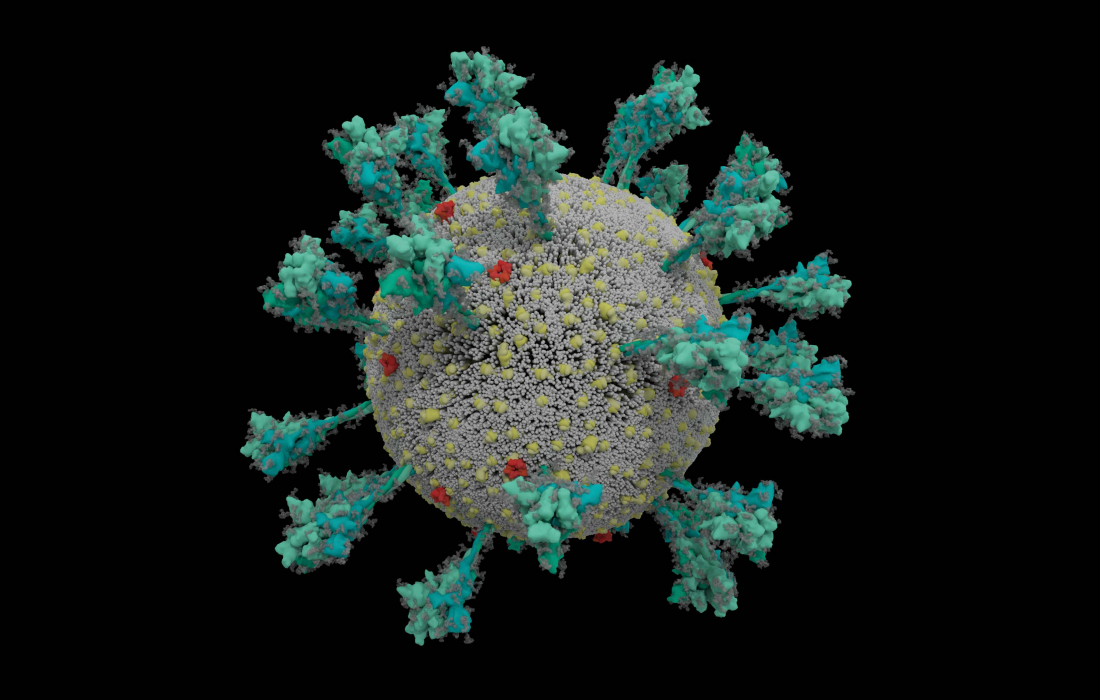COVID-19
How the Coronavirus Infects Uur Cells and Why the New Delta Variant is o Dangerous
The coronavirus sports a luxurious sugar coat. “It’s striking,” thought Rommie Amaro, staring at her computer simulation of one of the trademark spike proteins of SARS-CoV-2, which stick out from the virus’s surface. It was swathed in sugar molecules known as glycans.
Many viruses have glycans covering their outer proteins, camouflaging them from the human immune system like a wolf in sheep’s clothing. Last year a group of researchers created a detailed visualization of this coat using a supercomputer.
The spike protein of SARS-Cov-2 is coated in sugar molecules, or glycans, which disguise it from the immune system.
Since the pandemic started, scientists have been developing detailed understanding of how SARS-CoV-2 infects cells to find a better way to interrupt the infection process through improvement treatments and vaccines and to learn why the latest strains, such as the delta variant, are more transmissible.
They found that the virus has developed key adaptations that help it grab on to human cells with surprising strength and hide itself once inside.
The Spikes
Each SARS-Cov-2 virion has an outer surface arranged with spike proteins that are its key to fusing with human cells. They are flexible, which allows the spikes to flop around, sway and rotate, which make it easier for them to scan the cell surface and for multiple spikes to bind to our cells. They attach to ACE2 receptors, which are present outside of most human throat and lung cells.
The worrying variants of SARS-Cov-2 tend to have mutations in the S1 subunit of the spike protein. The alpha variant includes ten changes in the spike protein sequence which facilitates the entry to the cells.
The delta variant, which is becoming the prevalent strain around the world, has multiple mutations in the S1 subunit that improve the stability of the virus and its ability to bind to the ACE2 receptor and evade the immune system.
Once the spikes bind to the ACE2, other proteins initiate a process that leads to merging of viral and cell membranes. The virus then ejects its genome directly into the cell. It does so in a faster way compared to SARS-CoV and avoids being trapped in endosomes. After the virus shoots its RNA into the cell, ribosomes translate 2 sections of viral RNA into long strings of amino acids. Later, more RNAs are generated including the ones that are used to make new virus particles such as the spike. The virus takes over the cell’s machinery to translate the mRNAs into proteins. It has a protein “Nsp1” that can chop up all cellular mRNAs that are not from the virus.
The virus has the capacity to shut down the cell’s alarm system. It prevents cellular mRNAs from leaving the nucleus, thus leaving the cell with no instructions to alert the immune system of the infection.
One of the reasons that the virus can be so deadly is because of its ability to evade the immune system for a long period of time. By the time our immune system realizes that there is a virus, there is an incredible quantity of virus that the immune system starts responding at an accelerated manner, causing the cytokine storm characteristic of the disease.
After binding to our cells, enzymes called proteases that clip other proteins into pieces, cut or “prime” the spike protein to remove its outer segment, named S1, and reveal the inner segment S2.
Where other coronaviruses have a single arginine amino acid at the junction of the S1 and S2 subunits of the spike, SARS-CoV-2 has a line of five amino acids: proline, arginine, arginine, alanine and arginine. Two of the coronavirus variants, alpha and delta have different amino acids. In the alpha variant the proline is changed to histidine and in the delta is changed to arginine. Those small changes make it less acidic, thus causing the viral enzymes more capable of priming (cutting the spike protein).
More cuts means more spike proteins primed to enter human cells. The researchers think based on the study that this is the reason that the new variants are becoming highly transmissible. Because in SARS-Cov, less than 20% of spike proteins are primed, in SARS-CoV-2 that porcentaje rises to 50%. In the alpha variant is more than 50% and for the delta variant is greater than 75%.
Source:
https://media.nature.com/original/magazine-assets/d41586-021-02039-y/d41586-021-02039-y.pdf

